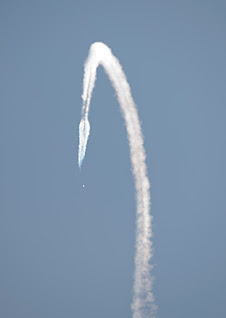 Sonic booms are a part of life at Edwards Air Force Base and in surrounding communities, so booms generated on June 11 by two F/A-18s from NASA’s Dryden Flight Research Center went relatively unnoticed. The exception included several NASA and Gulfstream engineers monitoring boom recording and measuring devices located in the Air Force Flight Test Center's museum and at a seismometer located on base.
Sonic booms are a part of life at Edwards Air Force Base and in surrounding communities, so booms generated on June 11 by two F/A-18s from NASA’s Dryden Flight Research Center went relatively unnoticed. The exception included several NASA and Gulfstream engineers monitoring boom recording and measuring devices located in the Air Force Flight Test Center's museum and at a seismometer located on base.Called Sonic Booms On Big Structures, or SonicBOBS, Phase 0, these flights were preliminary calibration flights for an upcoming NASA study scheduled for September that is designed to gather sonic boom data on larger buildings.
The project is part of a NASA effort to characterize the effect of sonic booms on ground structures. It is part of the agency's sonic boom reduction technology research to help make overland supersonic cruise a reality.
“We recorded nine loud and quiet sonic booms with a variety of sensors, both inside and outside buildings," said Ed Haering, Dryden's principal investigator for the SonicBOBS project. "These data will be used to tailor the experiment design for September’s flights,” Haering said.
For the flights, the two NASA F-18s flew both straight supersonic flight profiles as well as a unique supersonic diving profile designed to present a quieter sonic boom to specific locations along their flight path. The F-18s flew in Edwards' High Altitude Supersonic Corridor at 32,000 to 40,000 feet for the supersonic runs.
SonicBOBS complements previous efforts in 2006 and 2007 to measure the pressure and loudness of sonic booms on both older-and newer-construction base housing.
Window rattle and other contact-induced acoustic sources are important aspects of the high frequency response inside a building subjected to sonic booms. The earlier base housing research showed that indoor noise from sonic booms might be more annoying than the same booms heard outdoors.
Currently, Federal Aviation Administration regulations prohibit supersonic flight over land except in special restricted military flight corridors. A resurgent interest in the last 10 years by aerospace companies in supersonic business jets that could cruise supersonically over land led to several research projects to shape and modify supersonic shockwaves. Among them, the Shaped Sonic Boom Demonstrator Project by NASA, Northrop Grumman and DARPA and the QuietSpike Project by NASA and Gulfstream both demonstrated the successful suppression of sonic boom intensity on the ground.
NASA's Langley Research Center, Hampton, Va., and Gulfstream Aerospace Corporation, Savannah, Ga., are partners with NASA Dryden and the Air Force Flight Test Center in the project. The effort is funded by the NASA Aeronautics Research Mission Directorate’s Supersonics Project, which supports NASA's Fundamental Aeronautics program strategy of developing systems level, multidiscipline capabilities for supersonic civilian and military applications.
Friday, June 26, 2009
// //
0
comments
//
0 comments to "Supersonic Diving Quieting the Boom"
Popular Posts
-
Even though there are many advancement in technology, keeping foods fresher in space for a long period has been impossible. Research has b...
-
NASA is providing up to $20 million over the next five years to support a national program to inspire student interest in science, technolo...
-
NASA technologists will get a opportunity next summer time to experience the good old days when Organization technical engineers would conn...
-
Though the sun's brightness was once thought to be constant, NASA has launched a series of satellite instruments that have helpe...
-
X-24B Precision Landings Proved That Shuttle Could Land Unpowered NASA research pilot John Manke worked through his prelaunch checklist wh...
-
The mars rock touches the NASA curiosity this time it touches the more different from before Tasks. The mars rock is looks like some odd...
-
Images from NASA's Wide-field Infrared Survey Explorer (WISE) reveal an old star in the throes of a fiery outburst, spraying the cosm...
-
Leaner, greener flying machines for the year 2025 are on the drawing boards of three industry teams under contract to the NASA Aeronautics ...
-
The argument that the moon is a dry, desolate place no longer holds water. Secrets the moon has been holding, for perhaps billions of years,...












